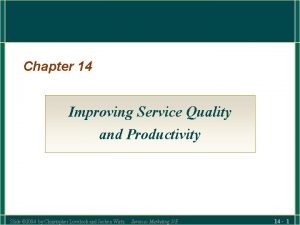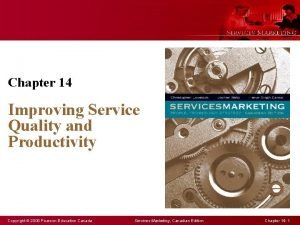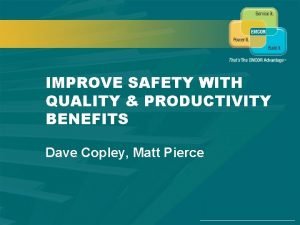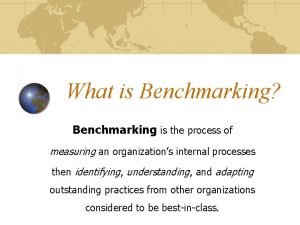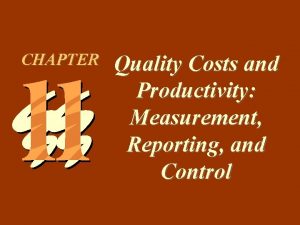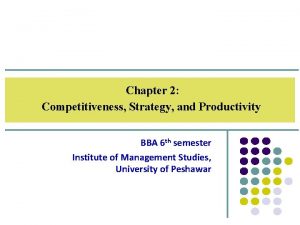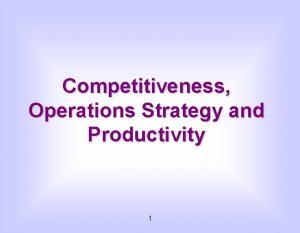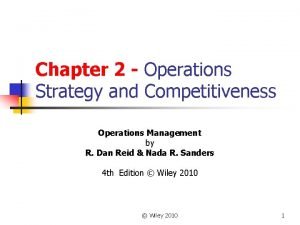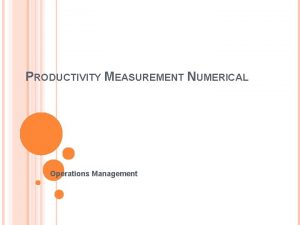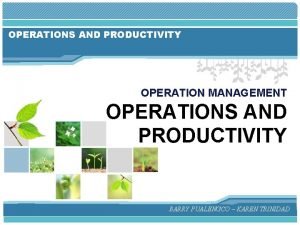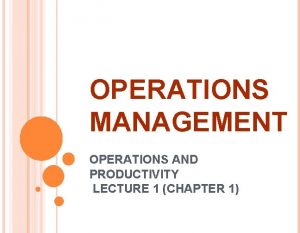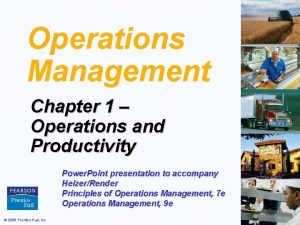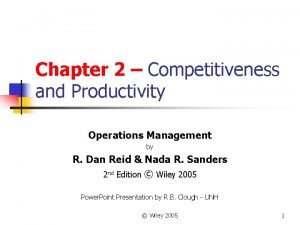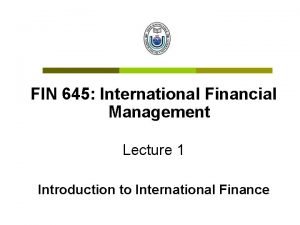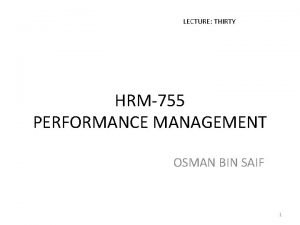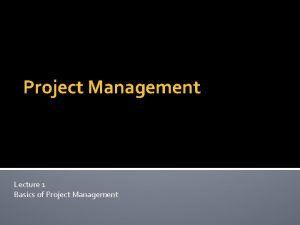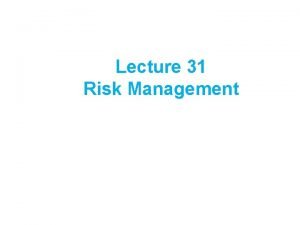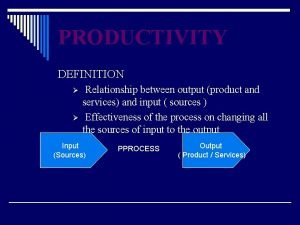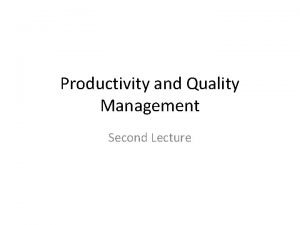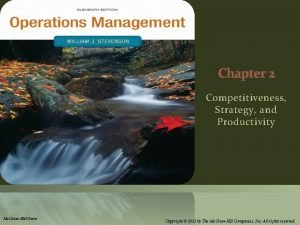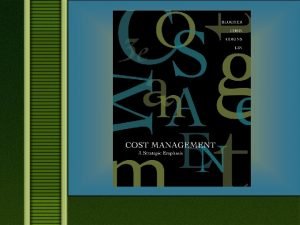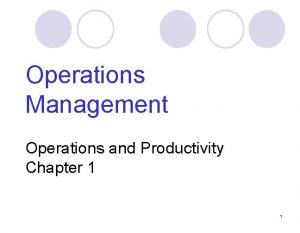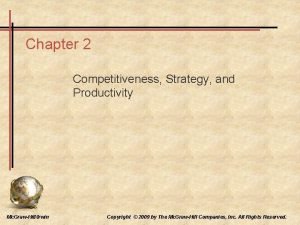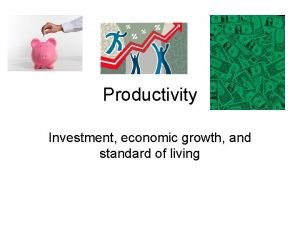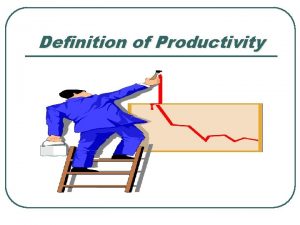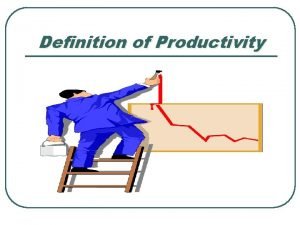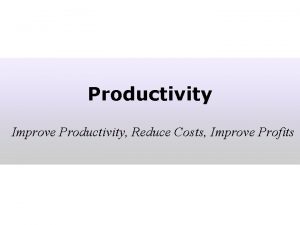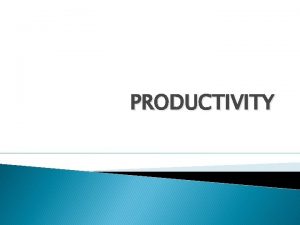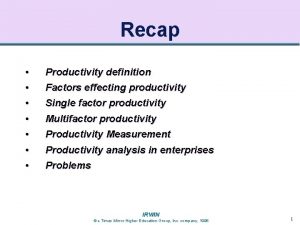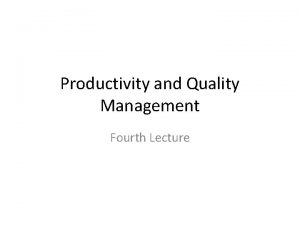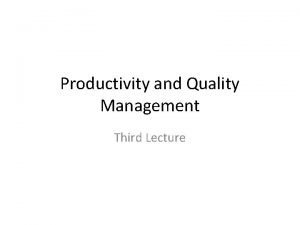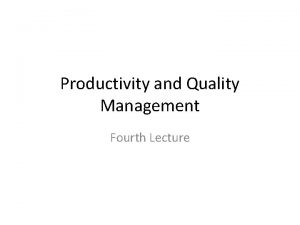Productivity and Quality Management Lecture 11 Summary Last





















































- Slides: 53



Productivity and Quality Management Lecture 11

Summary Last Lecture • Many of the perceived threats are result of problems in the organization that need to be understood and resolved. • Managing the introduction of a productivity measurement process involves managing resistance to change.

Summary Last Lecture • Quick Productivity Appraisal – Integrated audit approach – Includes diagnosis and monitoring of a productivity improvement program covering a whole organization • • Steps in Company Performance Appraisal (CPA) Problems of Productivity Analysis Misunderstanding of Productivity measurement Sound Productivity measurement system

Total Productive Maintenance

Objectives of This Lecture Answers of the following questions are able to tell what role TPM can play within a company: Ø Does TPM replace traditional maintenance techniques ? Ø Why is it so popular and important ? Ø What are its policies and objectives ? Ø How does it fit in with TQM ? Ø What are its steps, activities and components? Ø What are its benefits and results ?

What is Maintenance? • Any Idea? Maintenance, repair and operations (MRO) or maintenance, repair, and overhaul involves fixing any sort of mechanical, plumbing or electrical device should it become out of order or broken (known as repair, unscheduled, or casualty maintenance).

TPM is a productive maintenance implemented by all employees in an organization. TPM involves everyone in the organization from operators to senior management in equipment improvement.

What is TPM? • Total Productive Maintenance (TPM) is both – a philosophy to permeate throughout an operating company touching people of all levels – a collection of techniques and practices aimed at maximizing the effectiveness (best possible return) of business facilities and processes

The TPM Philosophy

The TPM Philosophy It is a Japanese approach for • Creating company culture for maximum efficiency • Striving to prevent losses with minimum cost – Zero breakdowns and failures, Zero accident, and Zero defects etc • The essence of team work (small group activity) focused on condition and performance of facilities to achieve zero loss for improvement • Involvement of all people from top management to operator

TPM in three words: Total = All individuals in the organization working together. Productive = production of goods that meet or exceed customer’s expectations. Maintenance = keeping equipment and plant in good condition at all times.

Total Productive Management • Total Productive Maintenance transforms maintenance into a crucial part of the business structure instead of being merely a non-profit activity. • The crucial tenet is to keep unscheduled and emergency maintenance to a minimum. • This lecture will discuss the different aspects of TPM including the following: • TPM targets: zero defects, zero breakdowns and zero accidents • Aligning the maintenance team to priorities • Implementing TPM: where to begin • Measuring TPM performance: the key to effective asset management • Communicating TPM

Total Productive Management • TPM is a management process developed for improving productivity by making processes more reliable and less wasteful. • TPM is an extension of TQM (Total Quality Management). • The objective of TPM is to maintain the plant or equipment in good condition without interfering with the daily process. • To achieve this objective, preventive and predictive maintenance is required. • By following the philosophy of TPM we can minimize the unexpected failure of the equipment. • To implement TPM the production unit and maintenance unit should work jointly.

Original Goal of TPM • “Continuously improve all operational conditions, within a production system; by stimulating the daily awareness of all employees” (by Seiichi Nakajima, Japan, JIPM) • TPM focuses primarily on manufacturing (although its benefits are applicable to virtually any "process") and is the first methodology Toyota used to improve its global position (1950 s). • After TPM, the focus was stretched, and also suppliers and customers were involved (Supply Chain), this next methodology was called lean manufacturing. • This following gives an overview of TPM in its original form.

Positive Results of TPM • An accurate and practical implementation of TPM will increase productivity within the total organization, where: • A clear business culture is designed to continuously improve the efficiency of the total production system. • A standardized and systematic approach is used, where all losses are prevented and/or known. • All departments, influencing productivity, will be involved to move from a reactive- to a predictive mindset. • Transparent multidisciplinary organization in reaching zero losses. • Steps are taken as a journey, not as a quick menu. • Finally TPM will provide practical and transparent ingredients to reach operational excellence.

HISTORY OF TPM

History • An innovative Japanese concept. • Developed in 1951. • TPM is an evolving process, starting from a Japanese idea that can be traced back to 1952, when preventive maintenance was introduced into Japan from the USA (Deming). • Nippondenso was the 1 st company that implemented TPM in 1960. • Based on these developments Nippondenso was awarded the distinguished plant prize for developing and implementing TPM, by the Japanese Institute of Plant Engineers ( JIPE ). • This Nippondenso became the first company to obtain the TPM certifications.

History • In preventive maintenance, operators produced goods using machines and the maintenance group was dedicated to the work of maintaining those machines. • However, with the high level of automation of Nippondenso, maintenance became a problem as so many more maintenance personnel were now required. • So the management decided that much of the routine maintenance of equipment would now be carried out by the operators themselves.

Autonomous Maintenance • Autonomous Maintenance, one of the features of TPM, is more cost-effective as the operator (compared to a highly skilled engineer) is on a lower pay rate. • This is not to reduce costs however; the operator has a better understanding of the how the equipment works daily, can tell if an issue is appearing, can tell if quality is decreasing, and, through constant learning, is allowed to follow a career path to a better job. • The maintenance group then focused only on more complex problems and project work for long term upgrades.

The Role of Maintenance Group • The maintenance group performed equipment modification that would improve its reliability. • These modifications were then made or incorporated into new equipment. The work of the maintenance group, with the support and input from operators and production engineers, is then to make changes that lead to maintenance prevention and increased quality through fewer defects and a reduction in scrap levels. • Thus preventive maintenance along with maintenance prevention and maintainability improvement were grouped as productive maintenance. • The aim of productive maintenance was to maximize plant and equipment effectiveness to achieve the optimum life cycle cost of production equipment.

Adoption of TPM by Nippondenso • Nippondenso already had quality circles which involved the employees in changes. • Therefore, now, all employees took part in implementing Productive maintenance. • Based on these developments Nippondenso was awarded the distinguished plant prize for developing and implementing TPM, by the Japanese Institute of Plant Engineers (JIPE). • Thus Nippondenso of the Toyota group became the first company to obtain the TPM certifications.

GOALS : • Increase production quality. • Increase job satisfaction. • Using teams for continuous improvement. CONTINUOUS PROCESS IMPROVEMENT • Improve the state of maintenance • Empower employees

Why TPM: • Avoid wastages • Producing with good product quality. • Reducing cost • Produce a low batch quantity at the earliest time. • Non-defective finished goods

Principles of TPM �Use Overall Equipment Effectiveness (OEE) as a compass for success. �Improve existing planned maintenance systems �Work toward zero losses �Providing training to upgrade operations and maintenance skills �Involve everyone and utilize cross-functional teamwork

TYPES OF MAINTENANCE

TPM and Traditional Maintenance Ø Reactive maintenance inherently wasteful and ineffective with following disadvantages: • • • No warning of failure Possible safety risk Unscheduled downtime of machinery Production loss or delay Possible secondary damage

TPM and Traditional Maintenance Need for: • • • Stand-by machinery A stand-by maintenance team A stock of spare parts Costs include: • • • Post production Disrupted schedule Repair cost Stand-by machinery Spare parts

TPM and Traditional Maintenance Ø Real cost of reactive maintenance is more than the cost of maintenance resources and spare parts Ø Pro-active maintenance (planned, preventive and predictive) more desirable than reactive maintenance

TPM and Traditional Maintenance Ø TPM enables or provides: • • • The traditional maintenance practices to change from reactive to pro-active A number of mechanisms whereby ü Breakdowns are analyzed ü Causes investigated ü Actions taken to prevent further breakdowns Preventive maintenance schedule to be made more meaningful

TPM and Traditional Maintenance • • To ‘free up’ maintenance professionals to: ü Carry out scheduled and preventive maintenance ü Gather relevant information as important input to the maintenance system ü Keep the system up to date ü To review cost effectiveness To develop and operate a very effective maintenance system an integral part of manufacturing

Faults and Problems

Types of maintenance �Breakdown maintenance �Preventive maintenance . periodic maintenance( time based maintenance) . Predictive maintenance �Corrective maintenance �Maintenance prevention

Breakdown/Reactive maintenance �Repairs or replacements performed after a machine has failed to return to its functional state following a malfunction or shutdown. �e. g. , an electric motor of a machine tool will not start, a belt is broken, etc. �Under such conditions, production department calls on the maintenance department to rectify the defect. �After removing the fault, maintenance engineers do not attend the equipment again until another failure or breakdown occurs.

Preventive maintenance(1951) • The primary goal of preventive maintenance is to prevent the failure of equipment before it actually occurs. • It is designed to preserve and enhance equipment reliability by replacing worn components before they actually fail. • It is a daily maintenance which includes cleaning, inspection, oiling and re-tightening of equipments.

Long-term benefits of preventive maintenance: • • Improved system reliability. Decreased cost of replacement. Decreased system downtime. Better spares inventory management.

Benefits

Periodic maintenance (TBM) �Time based maintenance consists of periodically inspecting, servicing and cleaning equipment and replacing parts to prevent sudden failure and process problems. Benefits: �Extended life and use of the equipment. �Reliable production at the times when machine is needed most.

Predictive maintenance • This is a method in which the service life of important part is expected based on inspection or diagnosis, in order to use the parts to the limit of their service life. • Compared to periodic maintenance, predictive maintenance is condition based maintenance.

Benefits of predictive maintenance • Increased plant readiness due to greater reliability of the equipment. • Many industries report from two to ten percent productivity increases due to predictive maintenance practices. • Reduced expenditures for spare parts and labor. • Reduces the probability of a machine experiencing a disastrous failure, and this results in an improvement in worker safety.

Corrective maintenance ( 1957 ) �Maintenance actions carried out to restore a defective item to a specified condition �Corrective maintenance is probably the most commonly used approach, but it is easy to see its limitations. �When equipment fails, it often leads to downtime in production. �In most cases this is costly business. Also, if the equipment needs to be replaced, the cost of replacing it alone can be important. �It is also important to consider health, safety and environment (HSE) issues related to malfunctioning equipment.

Maintenance prevention (1960 ) • It indicates the design of a new equipment. • Weakness of current machines are sufficiently studied ( on site information leading to failure prevention, easier maintenance and prevents of defects, safety and ease of manufacturing ) and are incorporated before commissioning a new equipment.

TPM POLICY AND OBJECTIVES

Policy and objectives • To maximize overall equipment effectiveness (Zero breakdowns and failures, Zero accident, and Zero defects etc) through total employee involvement • To improve equipment reliability and maintainability as contributors to quality and to raise productivity

Policy and objectives • To aim for maximum economy in equipment for its entire life • To cultivate equipment-related expertise and skills among operators • To create a vigorous and enthusiastic work environment

TPM Corporate policy • To aim for world-class maintenance, manufacturing performance and quality • To plan for corporate growth through business leadership • To promote greater efficiency through greater flexibility • Revitalize the workshop and make the most of employee talents

SIMILARITIES AND DIFFERENCES OF TPM AND TQM

Similarities b/w TQM & TPM • Total commitment to the program by upper level management is required in both programs. • Employees must be empowered to initiate corrective action, and • A long range outlook must be accepted, as TPM may take a year or more to implement. • It is an on-going process which is a continuous process improvement.

Differences between TQM and TPM Category Object Mains of attaining goal Target TQM TPM Quality ( Output and effects ) Equipment ( Input and cause ) Systematize the management. It is software oriented Employees participation and it is hardware oriented Quality for PPM Elimination of losses and wastes.

Summary • Philosophy of Total Productive Maintenance (TPM) • History of TPM • Types of Maintenance • TPM Policies and Objectives • Similarities and Differences between TPM and TQM


Improving Productivity
 Randy pausch last lecture summary
Randy pausch last lecture summary Project management lecture notes doc
Project management lecture notes doc Improving service quality and productivity
Improving service quality and productivity Service quality and productivity
Service quality and productivity Safety quality productivity cost
Safety quality productivity cost Benchmarking lets an organization
Benchmarking lets an organization 01:640:244 lecture notes - lecture 15: plat, idah, farad
01:640:244 lecture notes - lecture 15: plat, idah, farad Quality productivity ratio
Quality productivity ratio Productivity and competitiveness in operations management
Productivity and competitiveness in operations management Operations strategy and competitiveness
Operations strategy and competitiveness Productivity and competitiveness in operations management
Productivity and competitiveness in operations management Supply chain management and total quality management ppt
Supply chain management and total quality management ppt Quality control and quality assurance
Quality control and quality assurance Basic concept of quality management
Basic concept of quality management Multifactor productivity formula operations management
Multifactor productivity formula operations management Productivity in operations management
Productivity in operations management The ten critical decisions of operations management include
The ten critical decisions of operations management include Productivity definition in operations management
Productivity definition in operations management Multifactor productivity operations management
Multifactor productivity operations management Quality management in operations management
Quality management in operations management What is tqm
What is tqm Project planning and management lecture notes ppt
Project planning and management lecture notes ppt Pmp quality vs grade
Pmp quality vs grade Quality metrics pmp
Quality metrics pmp Quality improvement vs quality assurance
Quality improvement vs quality assurance Compliance vs quality
Compliance vs quality Management gurus and their contributions
Management gurus and their contributions Quality is free: the art of making quality certain
Quality is free: the art of making quality certain Old quality vs new quality
Old quality vs new quality Lecture to a missionary summary
Lecture to a missionary summary Project procurement management lecture notes
Project procurement management lecture notes Strategic management lecture
Strategic management lecture 4 p's of software project management
4 p's of software project management Financial management lecture
Financial management lecture Objective of public sector accounting
Objective of public sector accounting Om 306
Om 306 Performance management lecture
Performance management lecture Management fifteenth edition
Management fifteenth edition Human resource management lecture chapter 1
Human resource management lecture chapter 1 Human resource management lecture chapter 1
Human resource management lecture chapter 1 Project cost management lecture notes
Project cost management lecture notes Project management lecture
Project management lecture Uphcp
Uphcp Risk management lecture
Risk management lecture Network management principles
Network management principles Production and productivity definition
Production and productivity definition Define productivity
Define productivity Nutrition and productivity
Nutrition and productivity Productivity as a property of language
Productivity as a property of language Competitiveness strategy and productivity
Competitiveness strategy and productivity Managing productivity and marketing effectiveness
Managing productivity and marketing effectiveness Operation and productivity chapter 1
Operation and productivity chapter 1 The methods and actions taken to accomplish strategies
The methods and actions taken to accomplish strategies Productivity and standard of living
Productivity and standard of living


